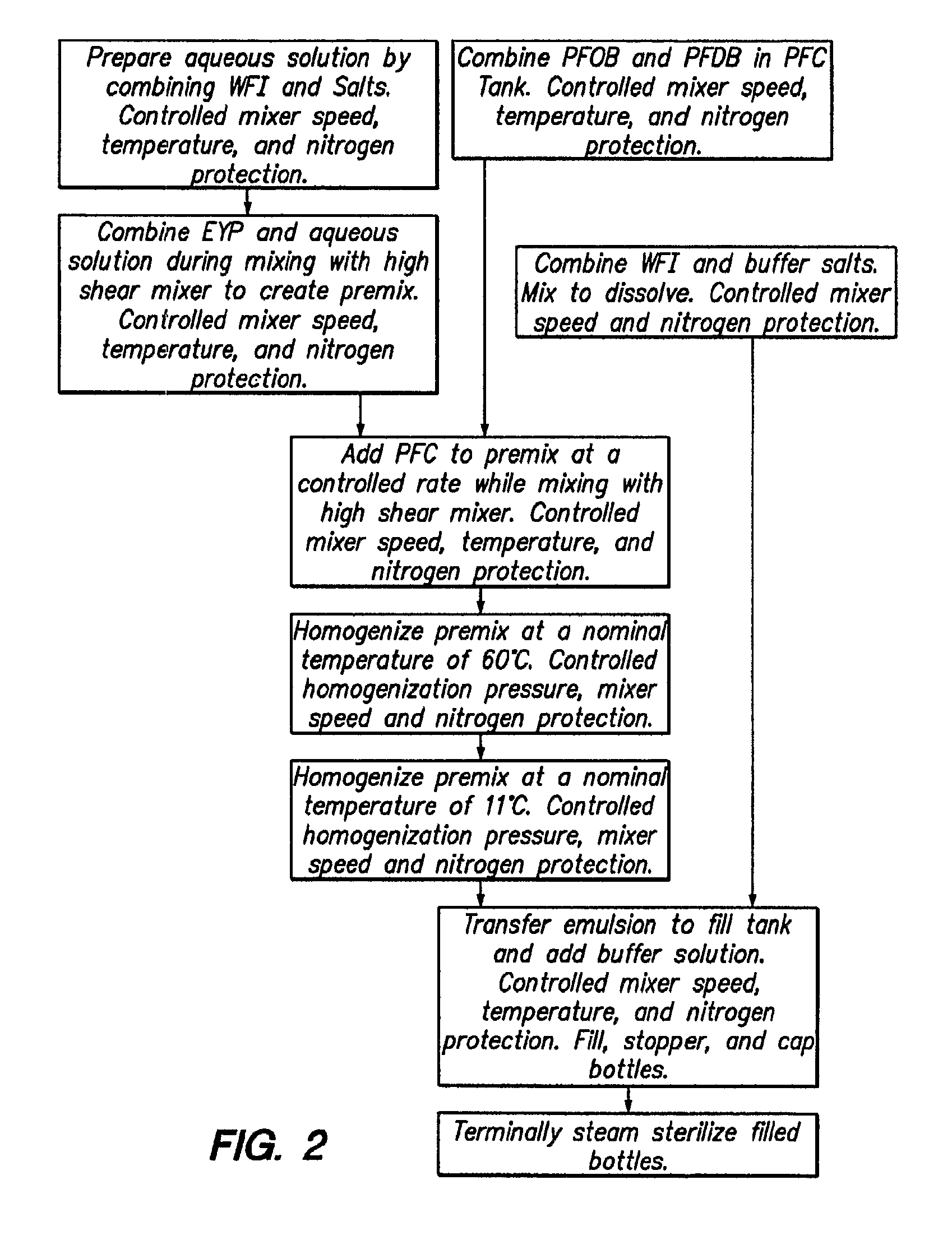Optimized fluorocarbon emulsions for blood substitutes and other therapeutic uses
a fluorocarbon emulsion and fluorocarbon technology, applied in the direction of drug compositions, ultrasonic/sonic/infrasonic diagnostics, extracellular fluid disorder, etc., can solve the problems of increased recurrence, serious morbidity and mortality, and unfavorable donor blood supply, so as to maintain emulsion stability and minimal organ retention time
- Summary
- Abstract
- Description
- Claims
- Application Information
AI Technical Summary
Benefits of technology
Problems solved by technology
Method used
Image
Examples
example i
Preparation of a 90% w / v PFOB Emulsion with 4% w / v EYP (90 / 4% w / v)
[0098]A reference emulsion containing 90 g PFOB, 4 g egg yolk phospholipid (EYP), and physiological levels of salts and buffers was prepared by high pressure homogenization according to the method of Long (U.S. Pat. No. 4,987,154 which is hereby incorporated by reference in its entirety) to obtain a 90% w / v PFOB emulsion. A secondary fluorocarbon, perfluorodecylbromide (PFDB), was then added to the 90% w / v PFOB emulsion in amounts containing 1%, 2%, 5%, and 10% (w / w) perfluorodecyl bromide to create one PFOB and four PFOB / PFDB emulsions. The four PFOB / PFDB emulsions prepared by the procedure of Example I were placed on accelerated stability testing at 40° C. for three months with a particle size analyzer.
[0099]Table I demonstrates particle size stability over time, tested with a particle size analyzer, for the one PFOB and four PFOB / PFDB fluorocarbon emulsions. Such emulsions include a control, in which 100% of the fl...
example ii
Stabilization of a 60% w / v PFOB Emulsion
Perfluoroctyl Bromide / Perfluorodecyl Bromide
[0102]An emulsion was prepared according to the procedure of Long (U.S. Pat. No. 4,987,154) and the teachings of Example I, but instead of a 90% w / v PFOB emulsion, a 60% w / v PFOB emulsion was made and a second 60% w / v PFOB emulsion stabilized with 10% w / v PFDB. Table II compares particle size increase on accelerated stability testing at 40° C. for a period of three months for a 60% w / v perflubron emulsion containing no PFDB to a 60% w / v perflubron emulsion containing 10% w / v PFDB. The stability testing was done with a particle size analyzer. Table II shows the reduction of particle growth over a three month period for the 60% w / v PFOB emulsion with 10% w / v PFDB added.
[0103]
TABLE IIStabilization of a 60% w / v Fluorocarbon Emulsion(Perfluoroctyl Bromide / Perfluorodecyl Bromide)SizeInitialafter 1Size after 2Size after 3SizemonthmonthsmonthsS × 1000Sample(μm)(40° C.)(40° C.)(40° C.)(μm3 / mo) 0% w / v PFDB0.20...
example iii
Differences in Intravascular Persistence for Fluorocarbons in Two-Component Disperse Phase Emulsions (60% PFOB w / v / 30% PFDB w / v)
[0105]FIG. 4 represents typical data for the removal of both PFOB and PFDB. FIG. 4 shows a plot of SdFFF fractogram obtained for a 60 / 30 (% w / v) ratio of PFOB / PFDB stabilized by 6% w / v EYP for the intravascular persistence of PFOB and PFDB in rats. In general, the rate constant for PFDB removal is 20-30% less than that of PFOB.
[0106]The emulsion composition with the data shown in FIG. 4 contains a 60 / 30% (w / v) ratio of PFOB / PFDB stabilized by 6% w / v EYP. In this case, the rate constant for PFDB removal is 20% higher than that of PFOB. It might be assumed that in the first few hours after administration that the removal from blood is controlled by k12 (see FIG. 1). The fluorochemical composition of circulating emulsion droplets should, therefore, remain intact. How is it then that the two disperse phase components could have different rate constants? To answ...
PUM
| Property | Measurement | Unit |
|---|---|---|
| median particle diameter | aaaaa | aaaaa |
| molecular mass | aaaaa | aaaaa |
| particle size | aaaaa | aaaaa |
Abstract
Description
Claims
Application Information
 Login to View More
Login to View More - R&D
- Intellectual Property
- Life Sciences
- Materials
- Tech Scout
- Unparalleled Data Quality
- Higher Quality Content
- 60% Fewer Hallucinations
Browse by: Latest US Patents, China's latest patents, Technical Efficacy Thesaurus, Application Domain, Technology Topic, Popular Technical Reports.
© 2025 PatSnap. All rights reserved.Legal|Privacy policy|Modern Slavery Act Transparency Statement|Sitemap|About US| Contact US: help@patsnap.com



